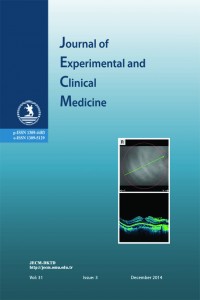Should computer-based medical education be a solution for treatment of rarely seen diseases? A forensic death case due to malignant hyperthermia
Abstract
We presented a case of a 33-year-old female who was admitted to hospital because of secondary infertility and underwent anesthesia for hysteroscopy. She was suspected to die from malignant hyperthermia during hysteroscopy process and accepted as forensic death. There were no data about postoperative biochemical findings and body temperature measurements. Histopathologic examinations showed pulmonary edema, intraalveolar edema and hemorrhage, chronic inflammation in the epiglottis and acute and chronic cervicitis. Creatinine kinase level was 11522 IU/L in postmortem analysis of serum (normal range 29 to 200 IU/L), creatine phosphokinase (CKMB) level was >500 ng/mL (Normal range 3.9 ng/mL) and myoglobin level was >800 ng/mL (normal range 0 to 70 ng/mL). In present study, limitations of postmortem investigations in the diagnosis of malignant hyperthermia have been emphasized and importance of the records kept before and during surgery has been discussed in terms of medicolegal aspects. Computer-based simulation technology is shown to be an effective method in anesthesiology education and becoming an essential part of the curriculum of anesthesia residency programs. We reckon that malignant hyperthermia should be presented before graduation by simulation programs in medical faculty and also similar postgraduate medical education activities should be settled. J. Exp. Clin. Med., 2014; 31:189-191 |
References
- Berkenstadt, H., Ziv, A., Barsuk, D., Levine, I., Cohen, A., Vardi, A., 2003. The use of advanced simulation in the training of anesthesiologists to treat chemical warfare casualties. Anesth. Analg. 96, 1739-1742.
- Bina, S., Muldoon, S., Bünger, R., 2008. Effects of ryanodine on skeletal muscle lactate and pyruvate in malignant hyperthermia-susceptible and normal swine as assessed by microdialysis. Eur. J. Anaesth. 25, 48-57.
- Christiansen, L.R., Collins, K.A., 2005. Pathologic findings in malignant hyperthermia: A case report and review of literature. Am. J. Forensic. Med. Pathol. 25, 327-333.
- Dong-Chan, K., 2012. Malignant hyperthermia. Korean Journal of Anesthesiology. 63, 391-401.
- McCarthy, T.V., Healy, J.M., Heffron, J.J., Lehane, M., Deufel, T., Lehmann-Horn, F., Farrall, M., Johnson, K., 1990. Localization of the malignant hyperthermia susceptibility locus to human chromosome 19q12-13.2. Nature. 343, 562-564.
- Morgan, P.J., Cleave-Hogg, D., McIlroy, J., Devitt, J.H., 2002. Simulation technology: A comparison of experiential and visual learning for undergraduate medical students. Anesthesiology. 96, 10-16.
- Robinson, R., Carpenter, D., Shaw, M.A., Halsall, J., Hopkins, P., 2006. Mutations in RYR1 in malignant hyperthermia and central core disease. Hum. Mutat. 27, 977-989.
- Rosenberg, H., Davis, M., Danielle, J., Pollock, N., Stowell, K., 2007. Malignant hyperthermia. Orphanet J. Rare Dis. 2, 21.
Abstract
References
- Berkenstadt, H., Ziv, A., Barsuk, D., Levine, I., Cohen, A., Vardi, A., 2003. The use of advanced simulation in the training of anesthesiologists to treat chemical warfare casualties. Anesth. Analg. 96, 1739-1742.
- Bina, S., Muldoon, S., Bünger, R., 2008. Effects of ryanodine on skeletal muscle lactate and pyruvate in malignant hyperthermia-susceptible and normal swine as assessed by microdialysis. Eur. J. Anaesth. 25, 48-57.
- Christiansen, L.R., Collins, K.A., 2005. Pathologic findings in malignant hyperthermia: A case report and review of literature. Am. J. Forensic. Med. Pathol. 25, 327-333.
- Dong-Chan, K., 2012. Malignant hyperthermia. Korean Journal of Anesthesiology. 63, 391-401.
- McCarthy, T.V., Healy, J.M., Heffron, J.J., Lehane, M., Deufel, T., Lehmann-Horn, F., Farrall, M., Johnson, K., 1990. Localization of the malignant hyperthermia susceptibility locus to human chromosome 19q12-13.2. Nature. 343, 562-564.
- Morgan, P.J., Cleave-Hogg, D., McIlroy, J., Devitt, J.H., 2002. Simulation technology: A comparison of experiential and visual learning for undergraduate medical students. Anesthesiology. 96, 10-16.
- Robinson, R., Carpenter, D., Shaw, M.A., Halsall, J., Hopkins, P., 2006. Mutations in RYR1 in malignant hyperthermia and central core disease. Hum. Mutat. 27, 977-989.
- Rosenberg, H., Davis, M., Danielle, J., Pollock, N., Stowell, K., 2007. Malignant hyperthermia. Orphanet J. Rare Dis. 2, 21.
Details
| Primary Language | English |
|---|---|
| Journal Section | Internal Medical Sciences |
| Authors | |
| Publication Date | November 6, 2014 |
| Submission Date | August 23, 2013 |
| Published in Issue | Year 2014 Volume: 31 Issue: 3 |
Cite

This work is licensed under a Creative Commons Attribution-NonCommercial 4.0 International License.


